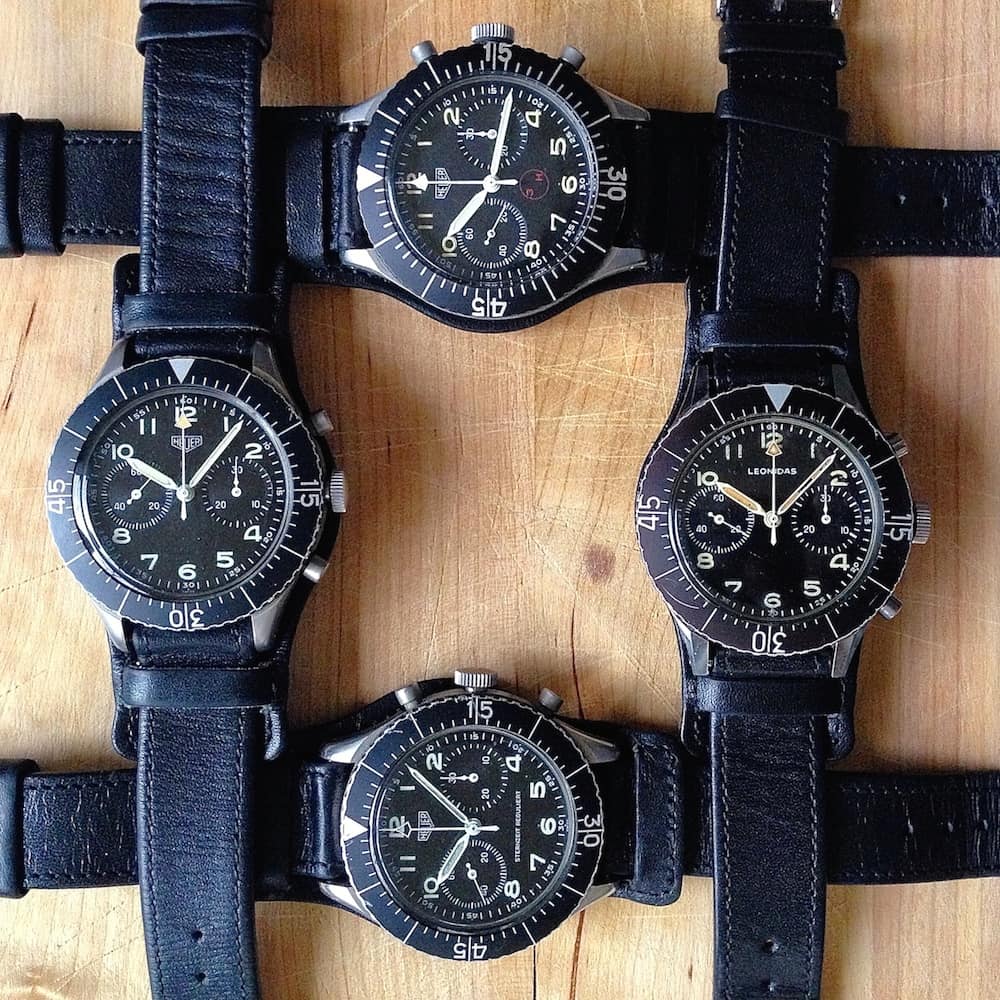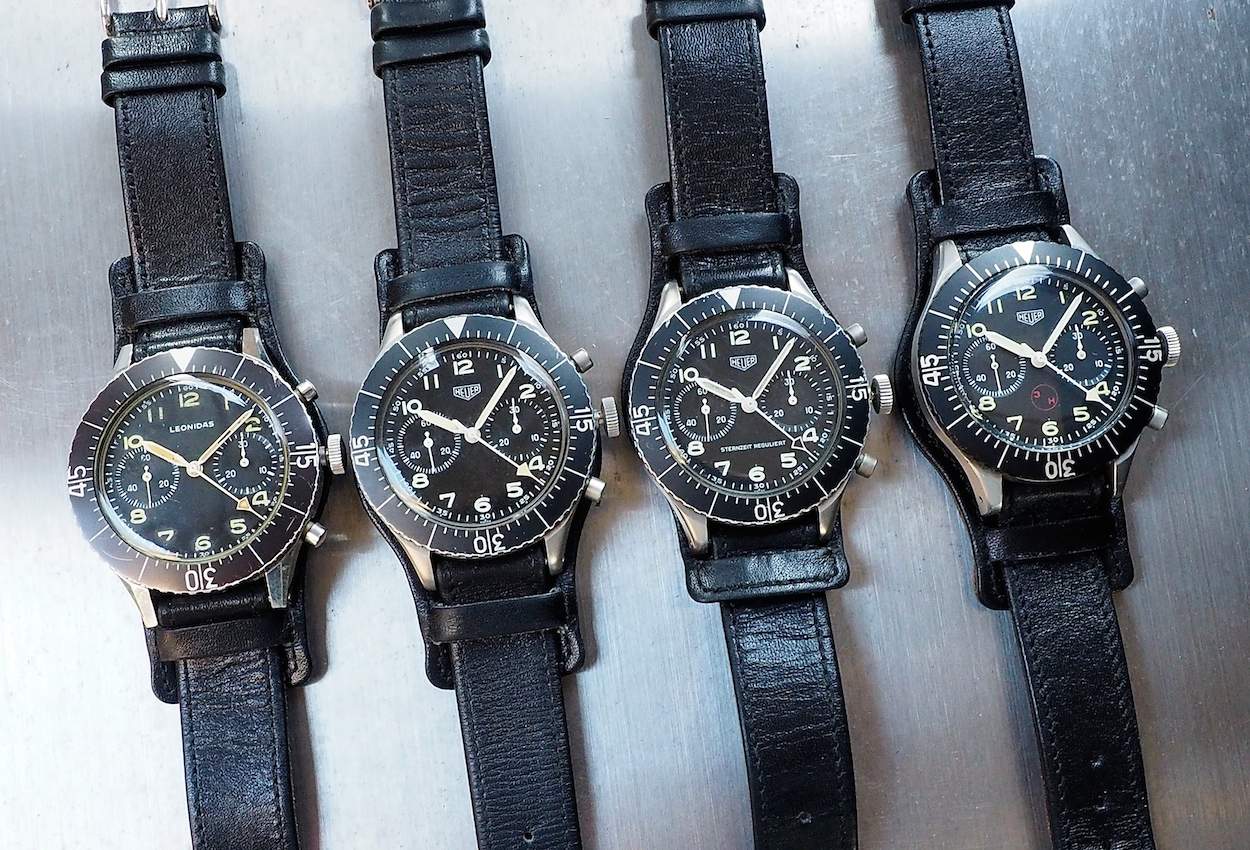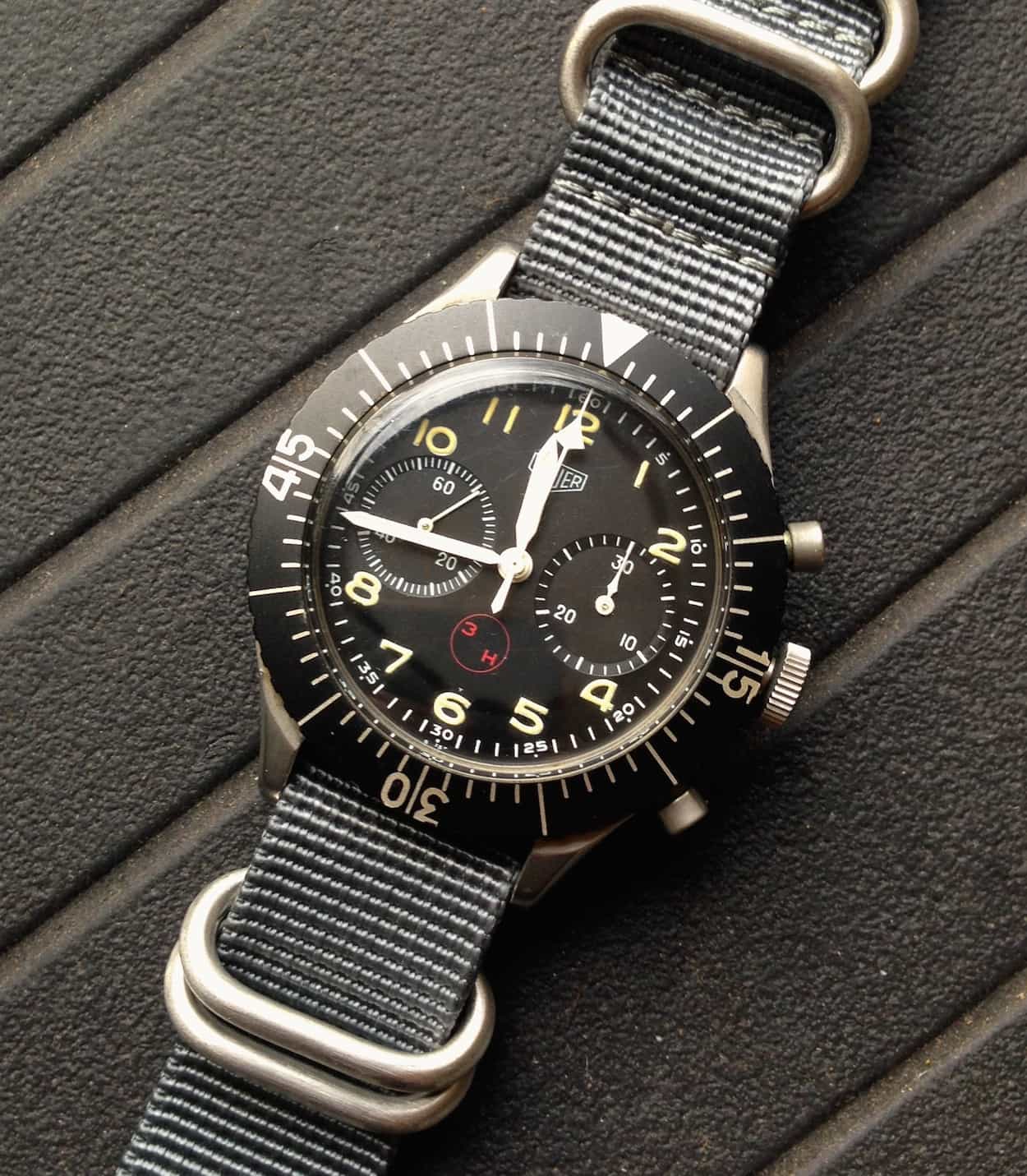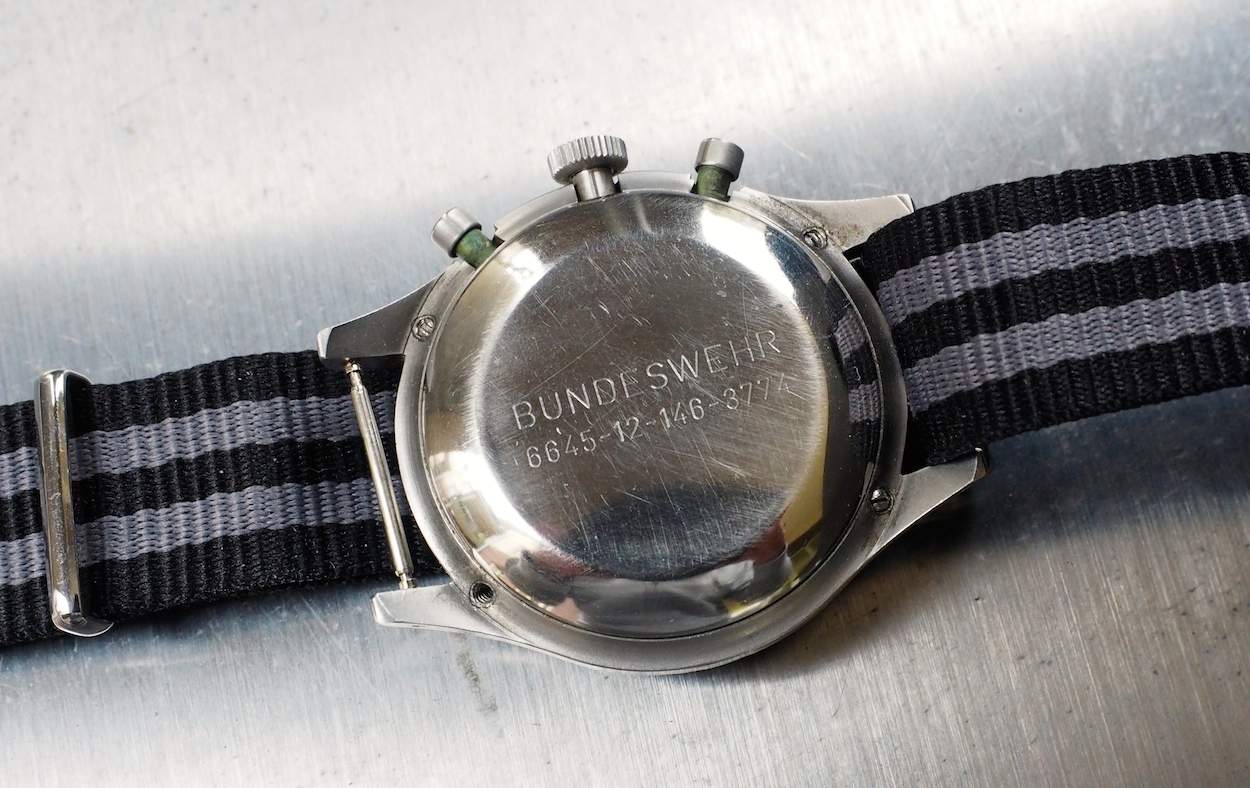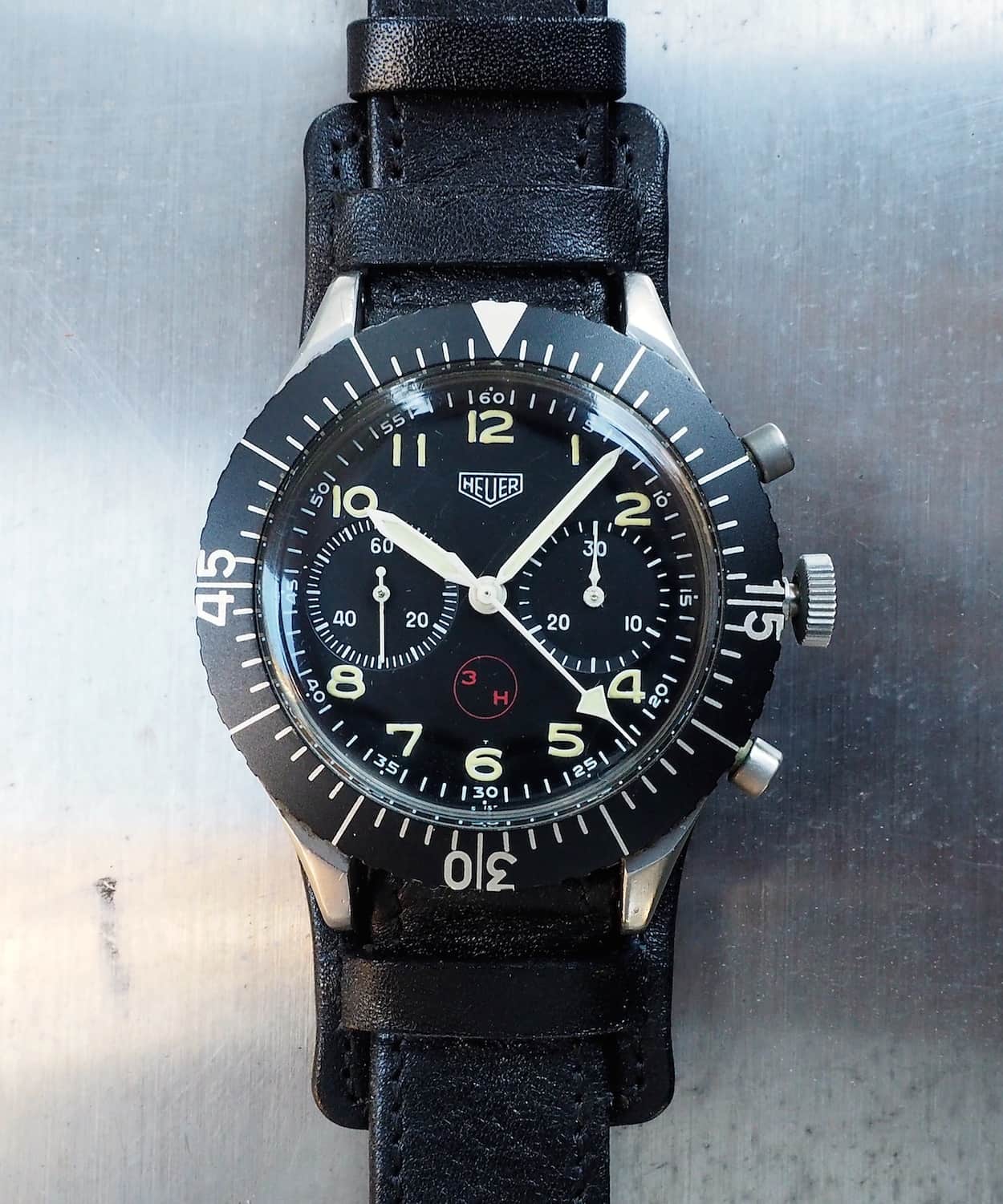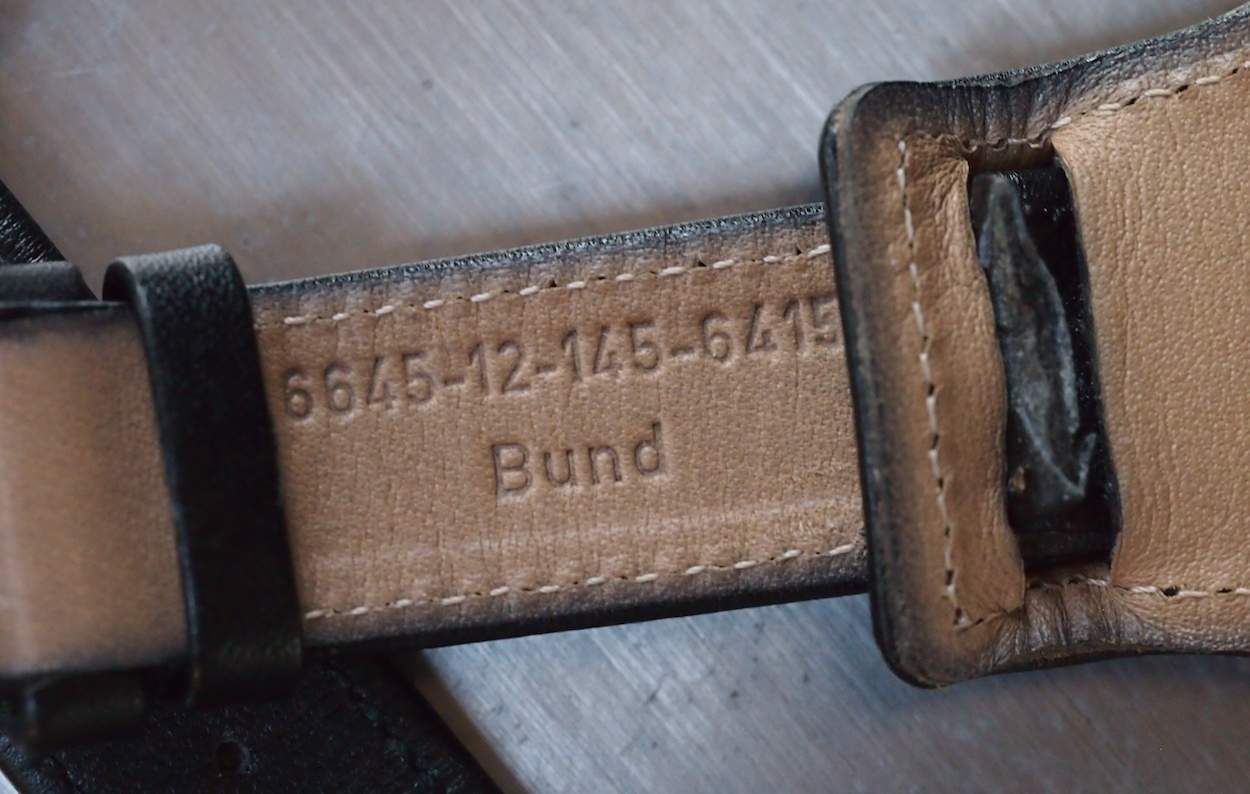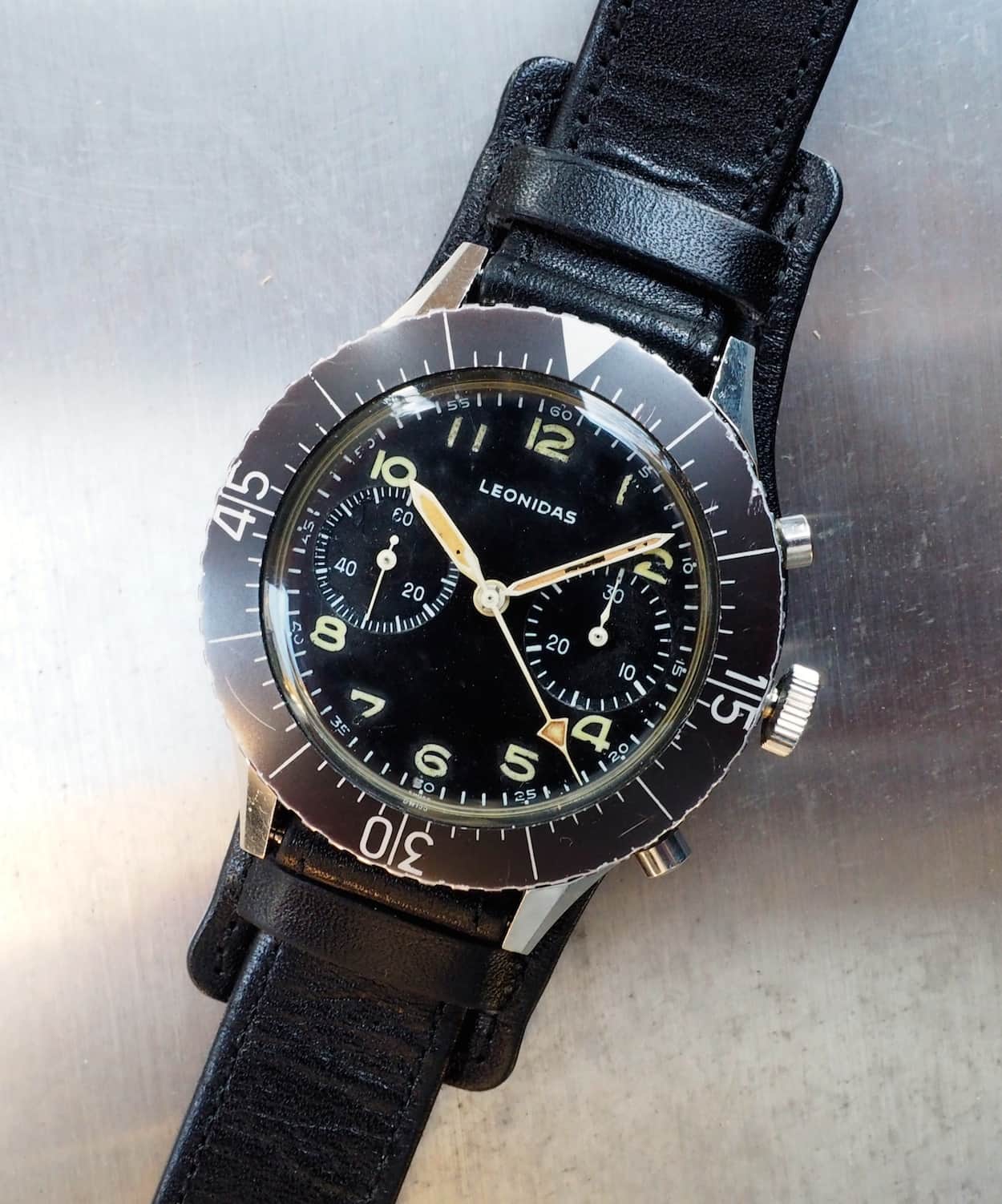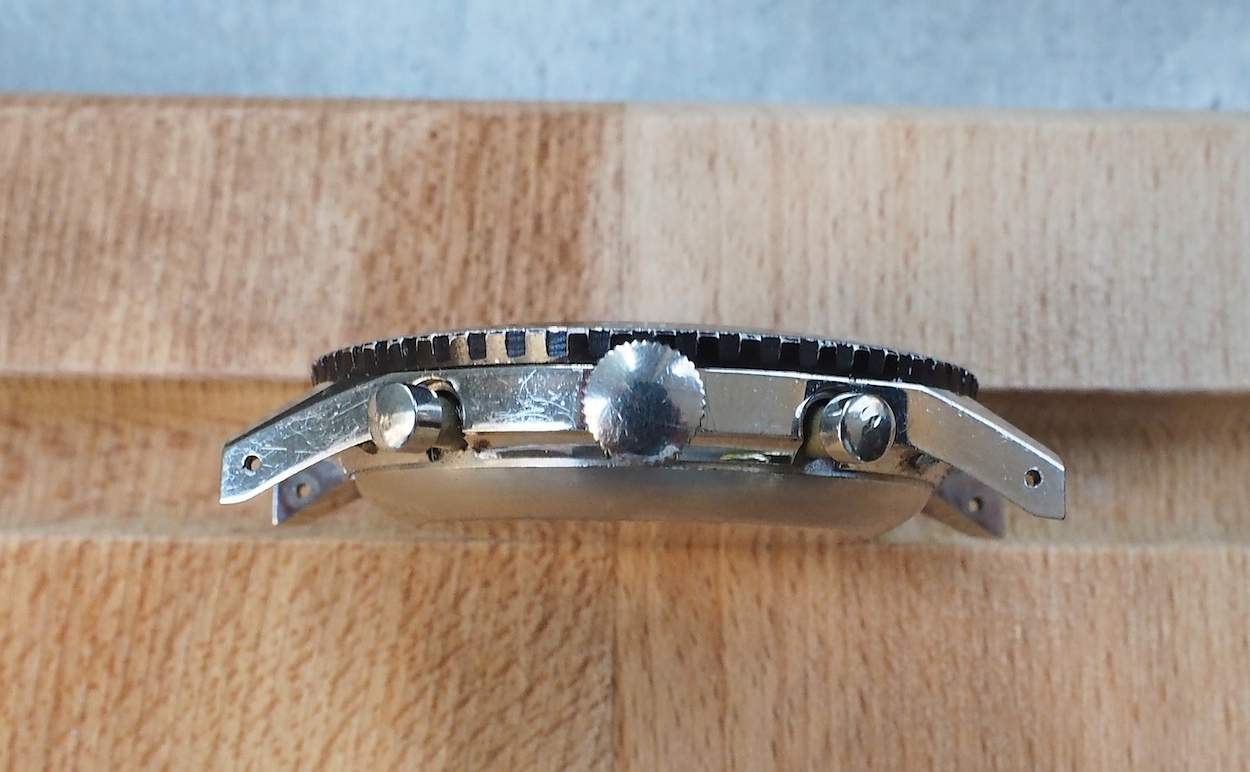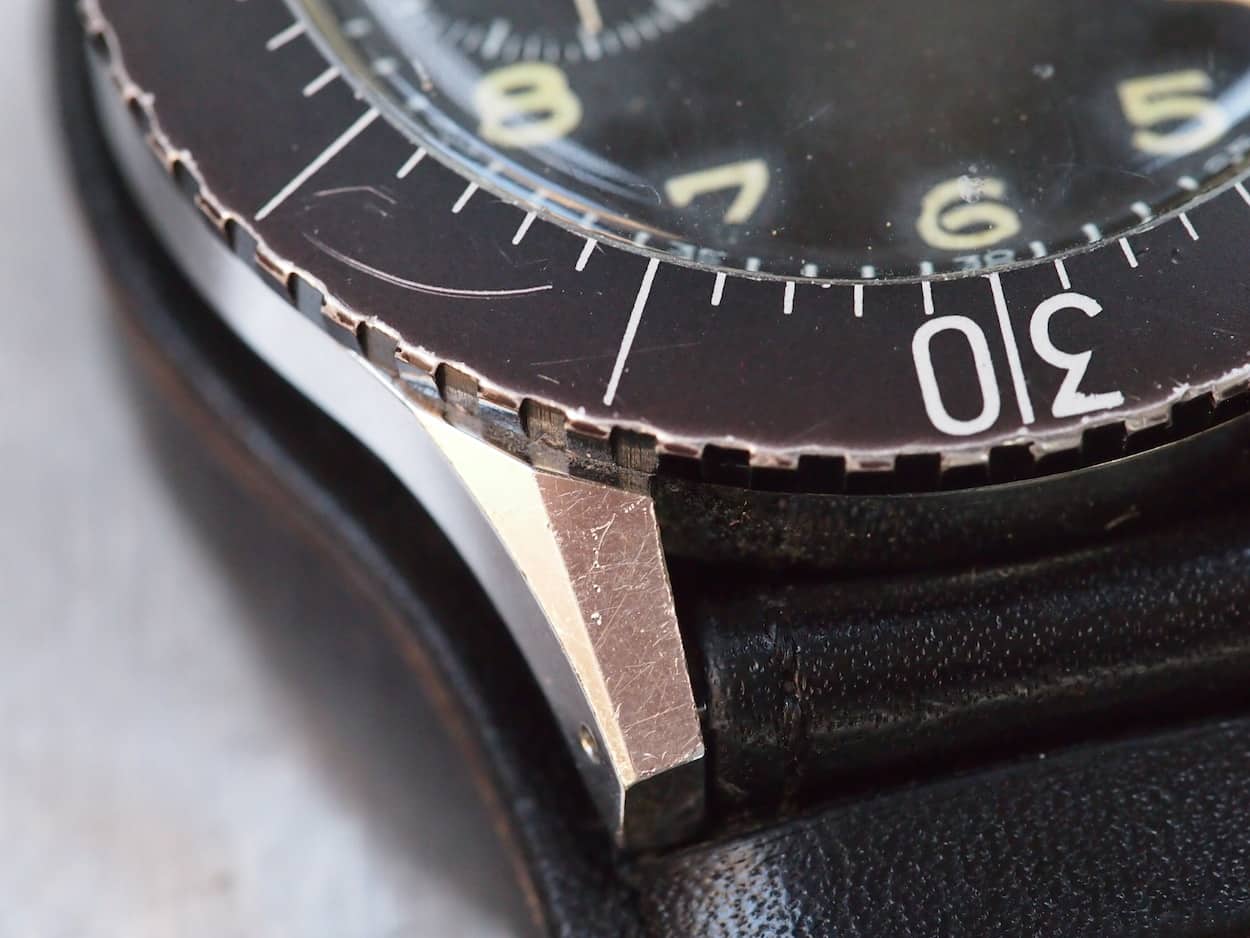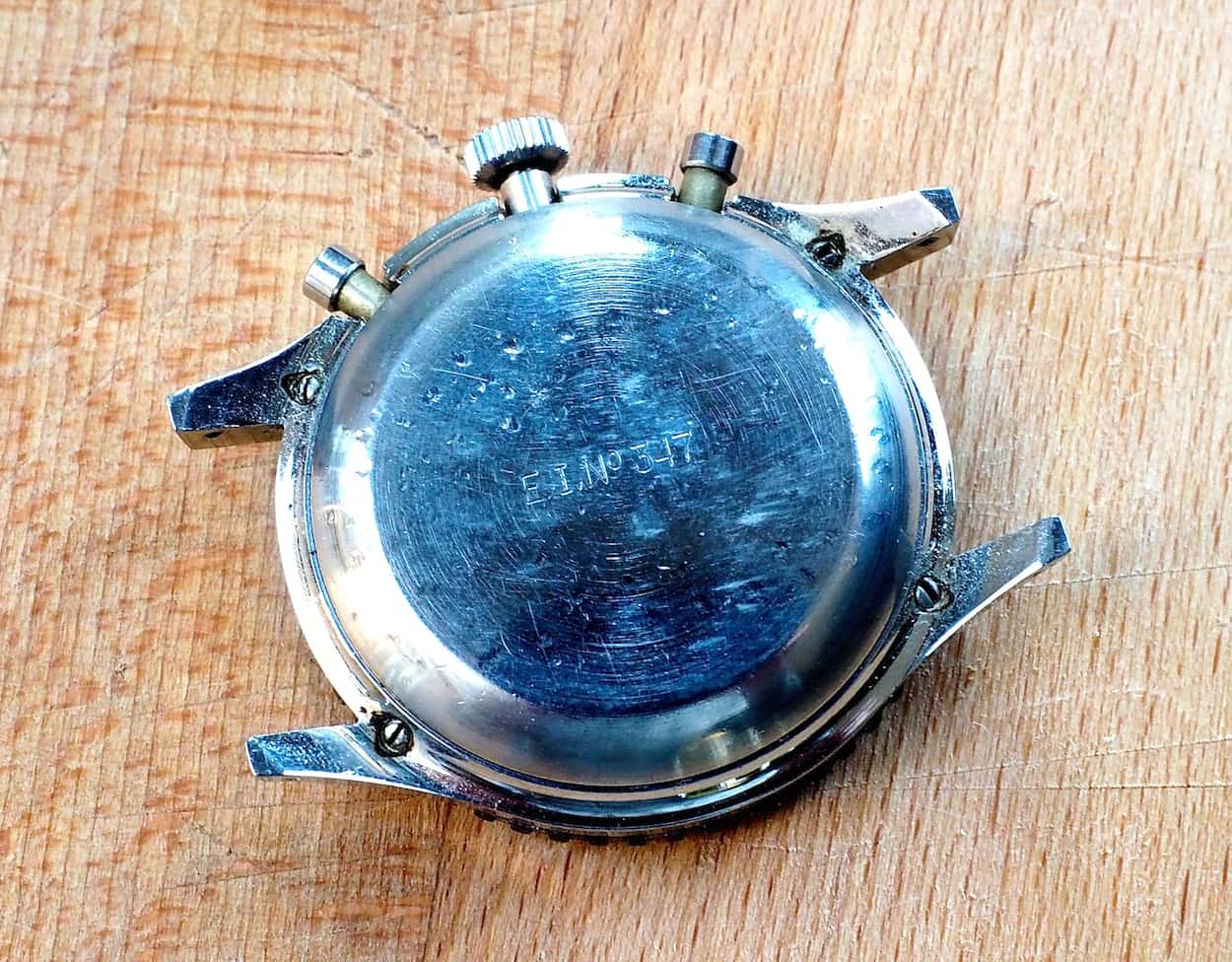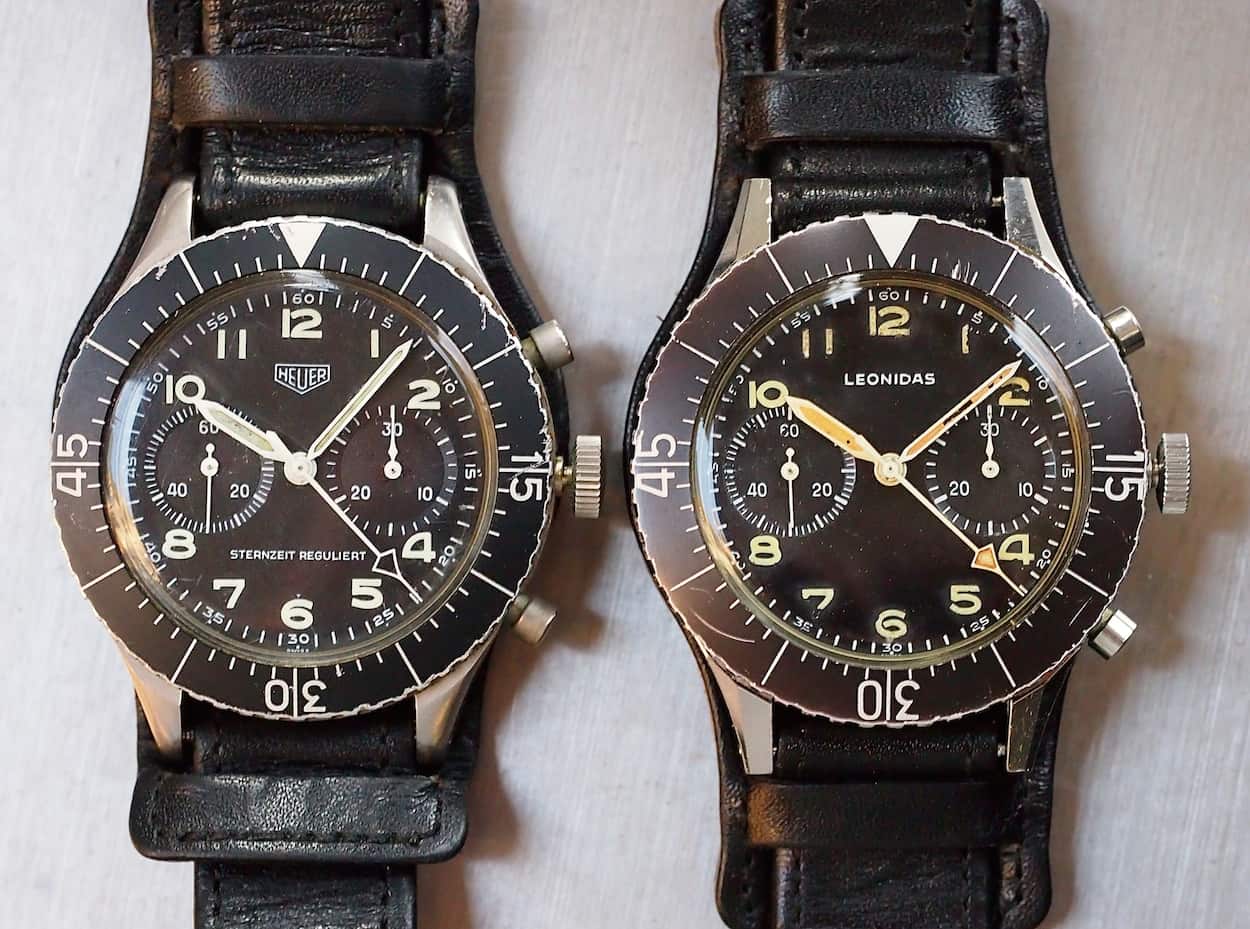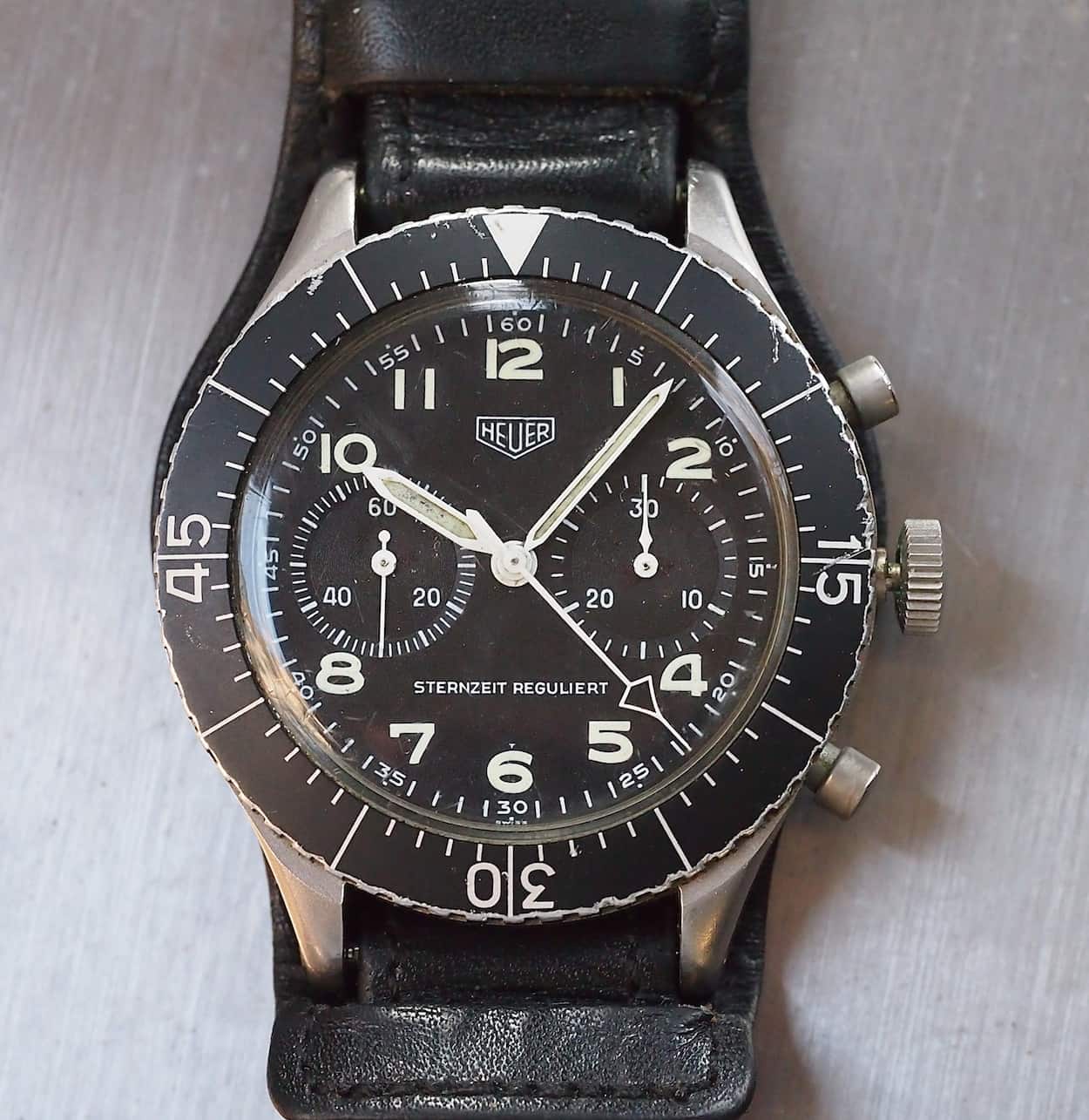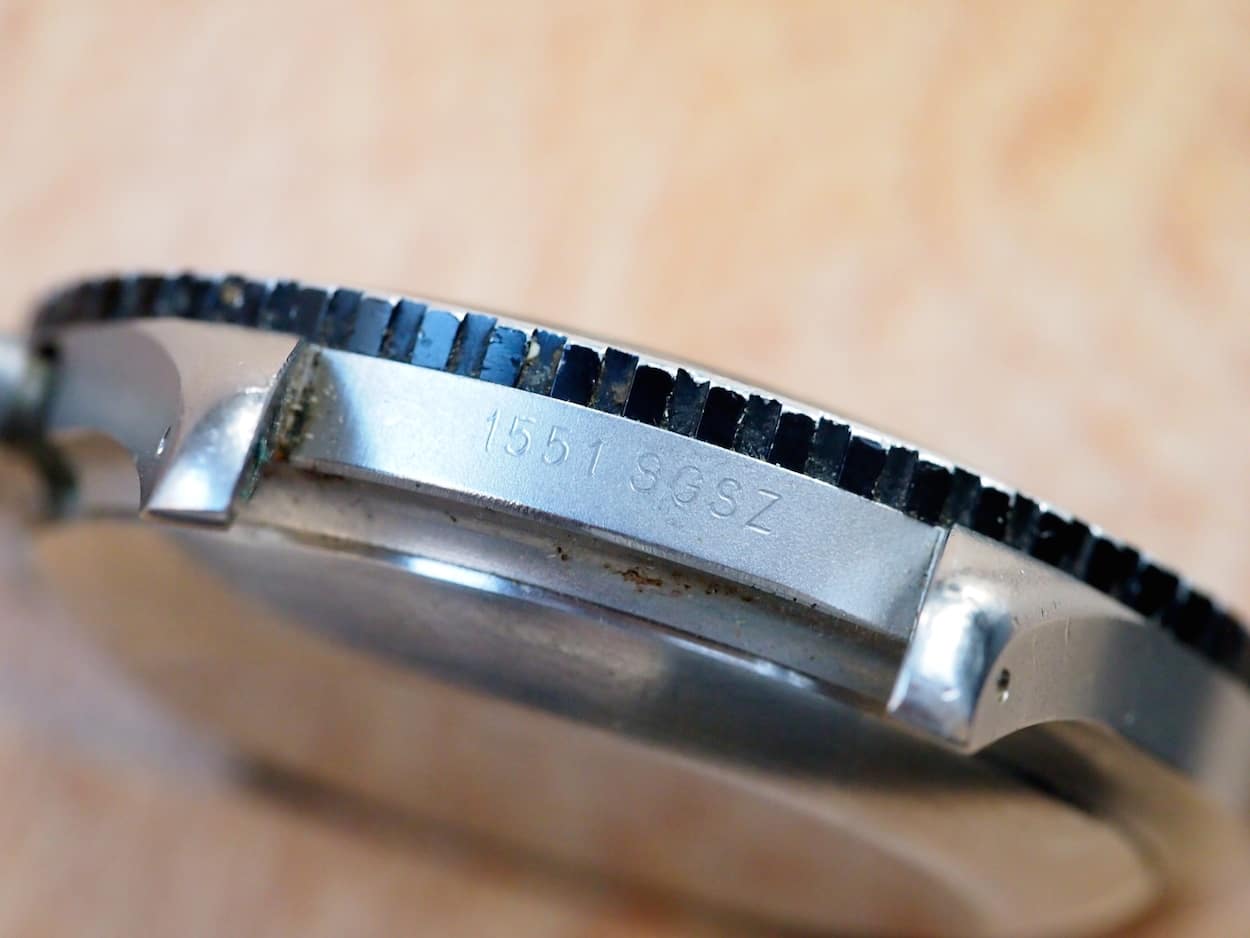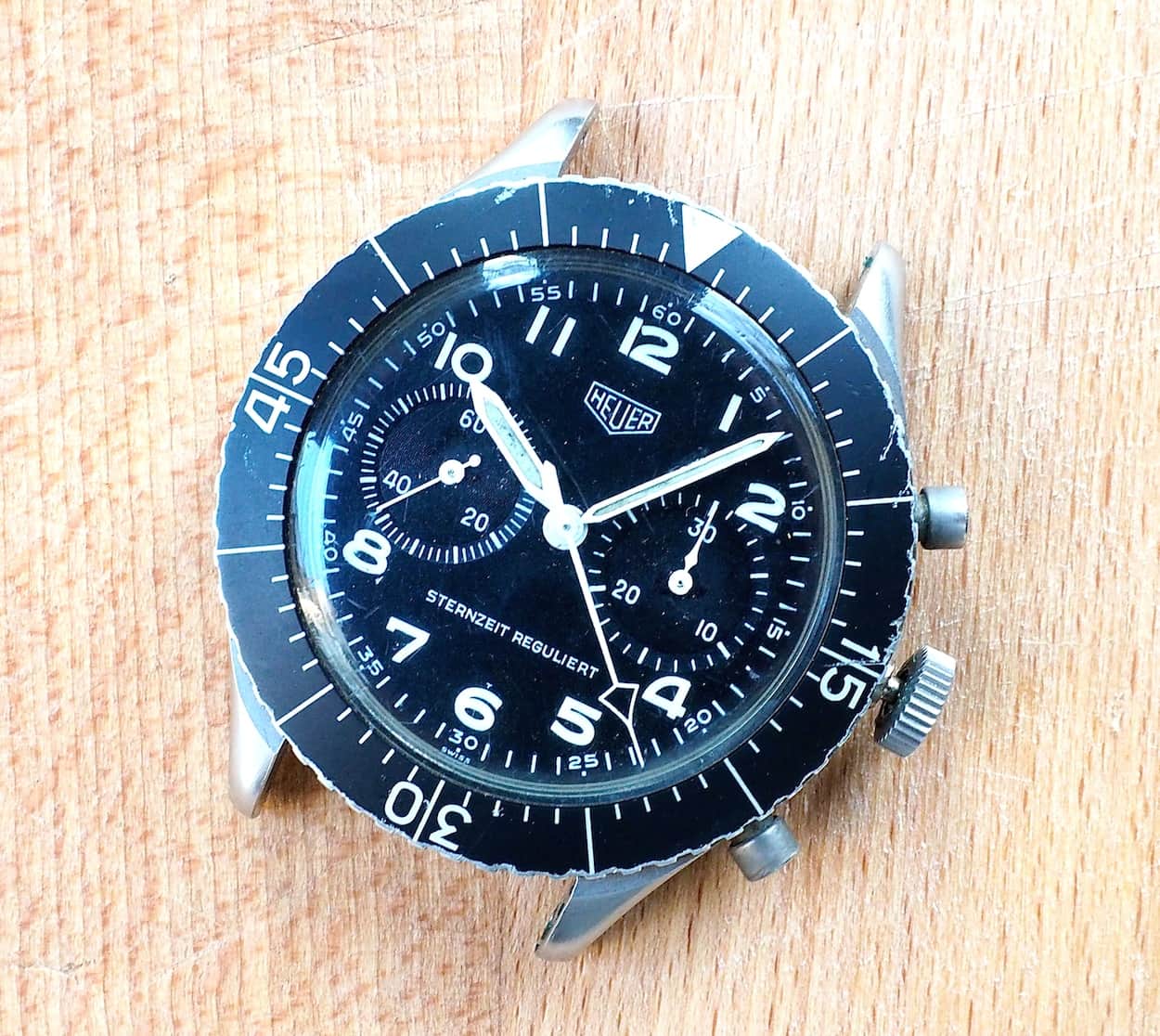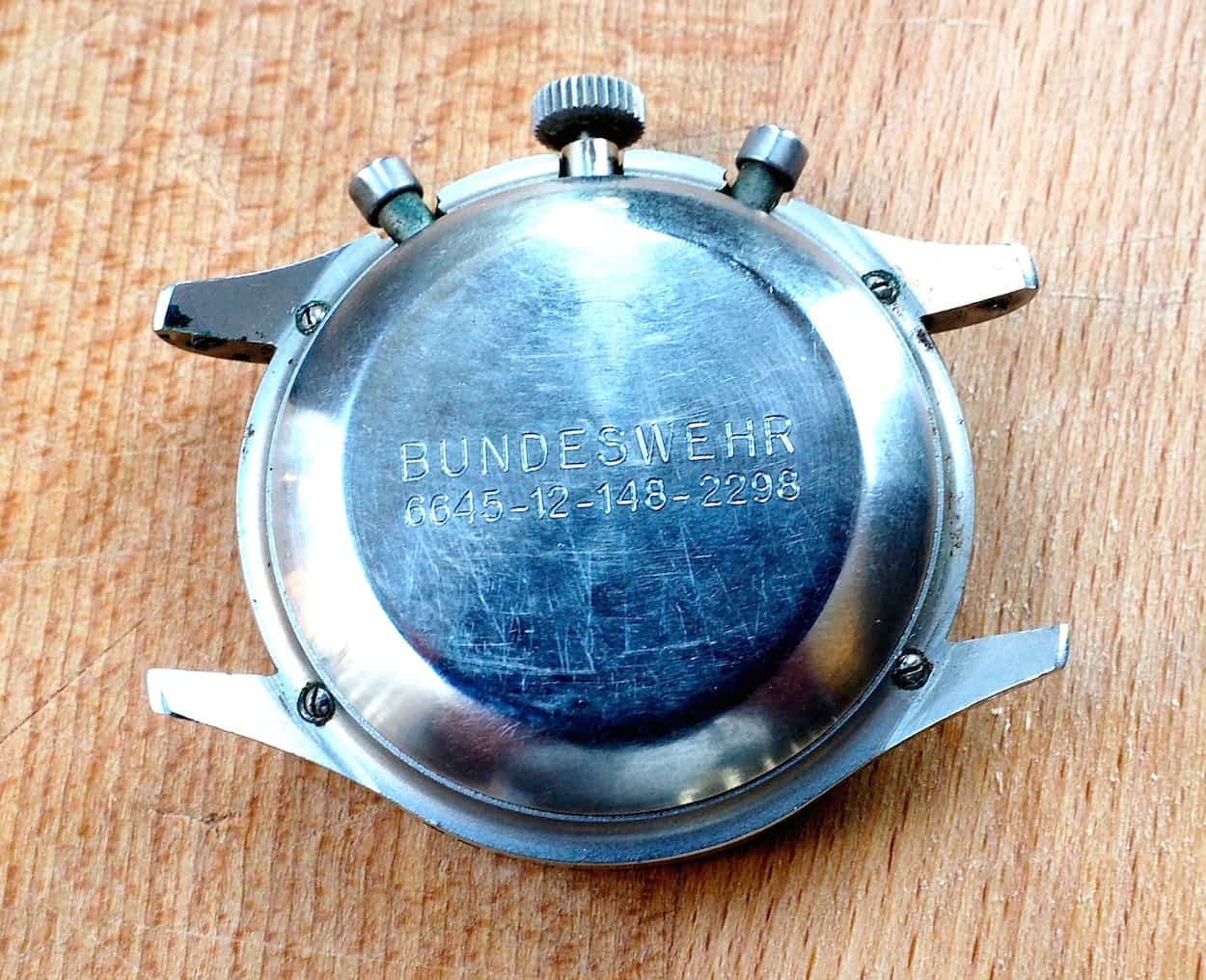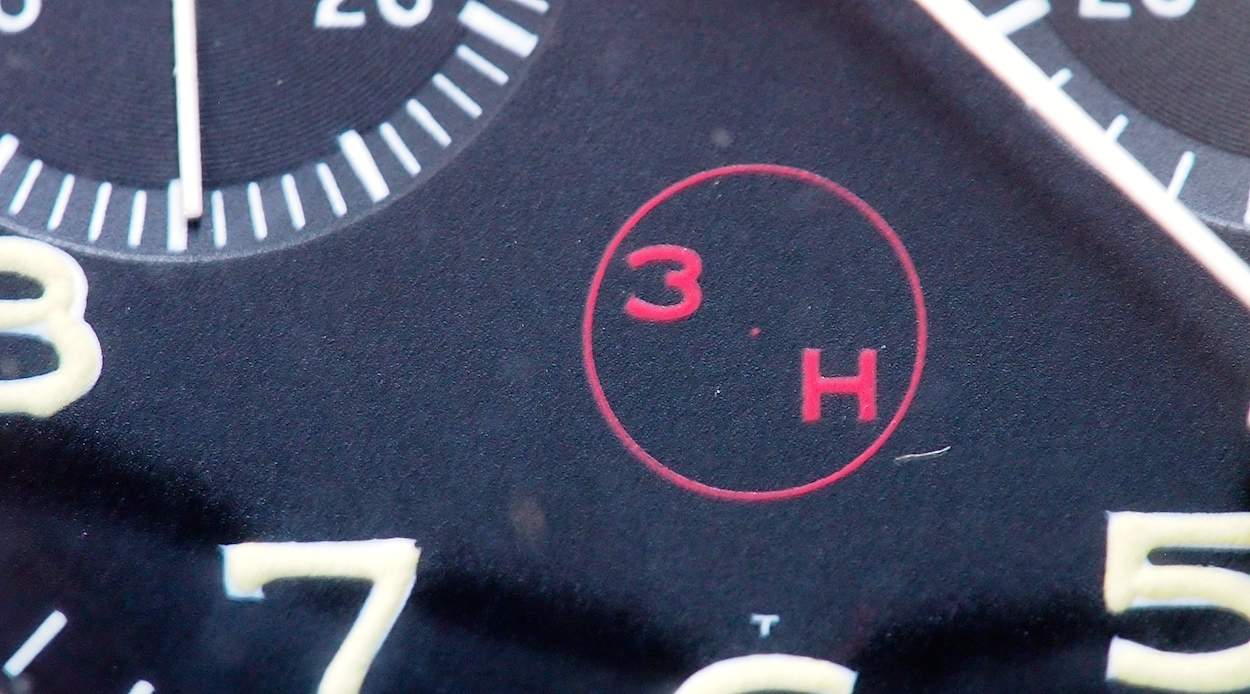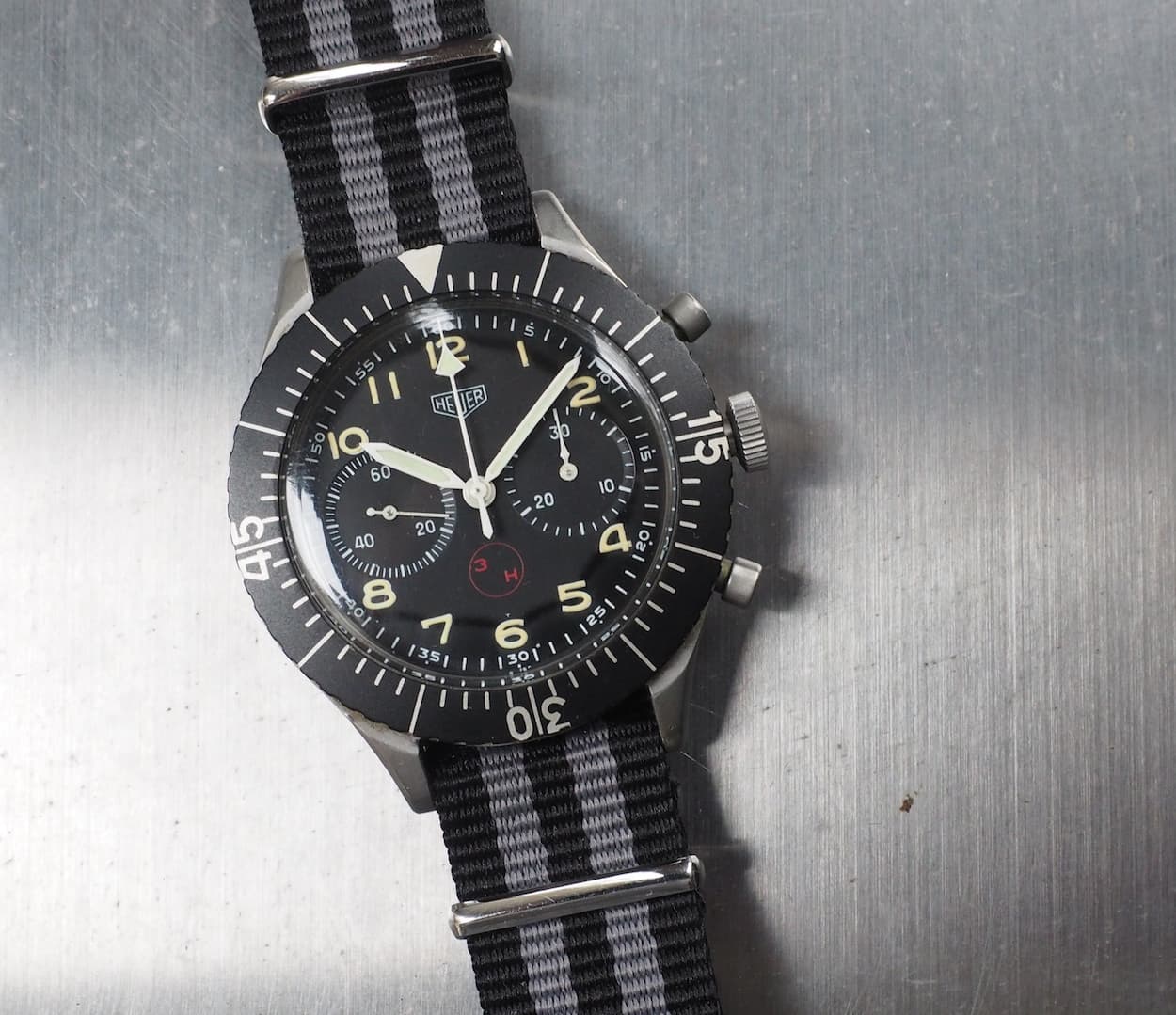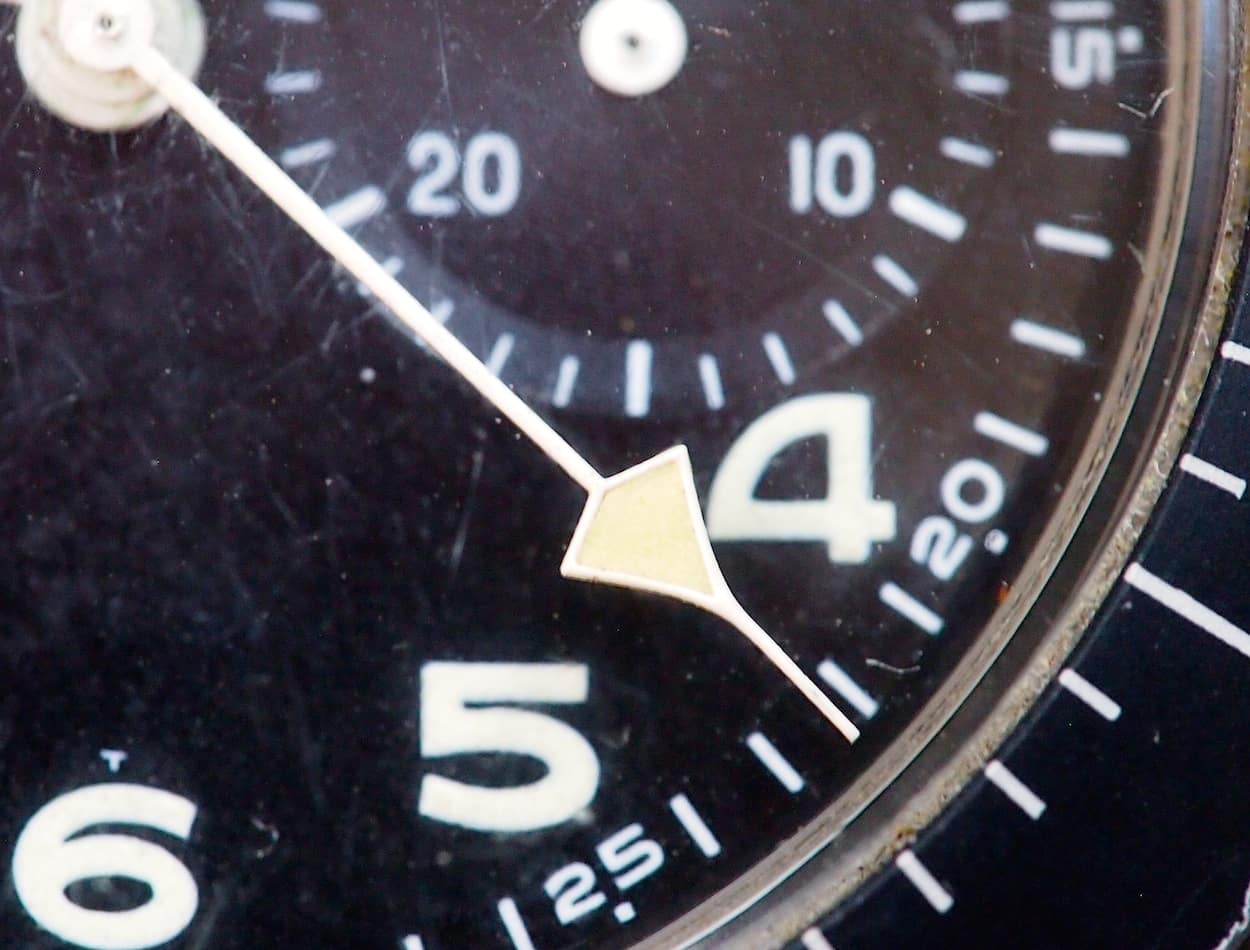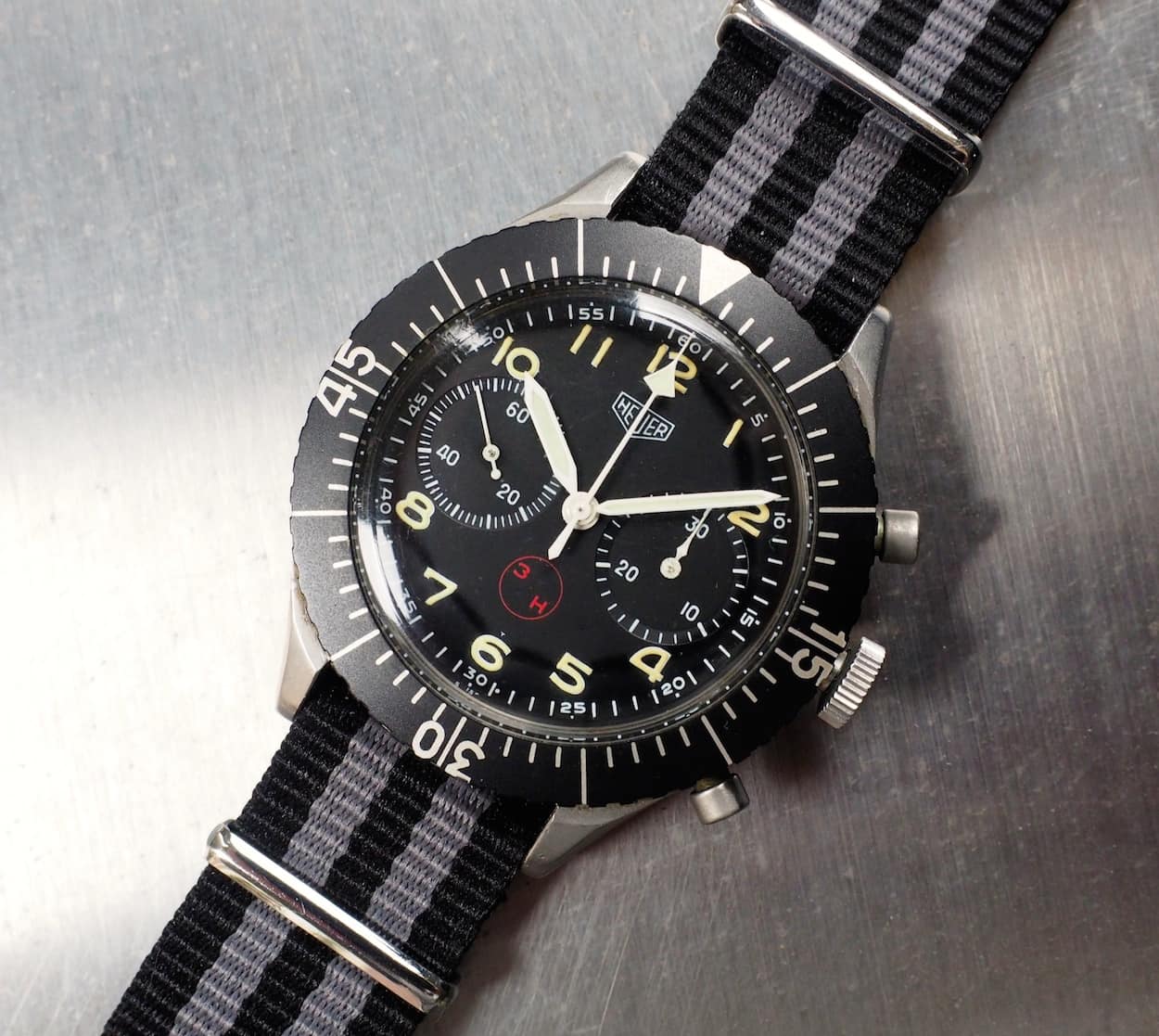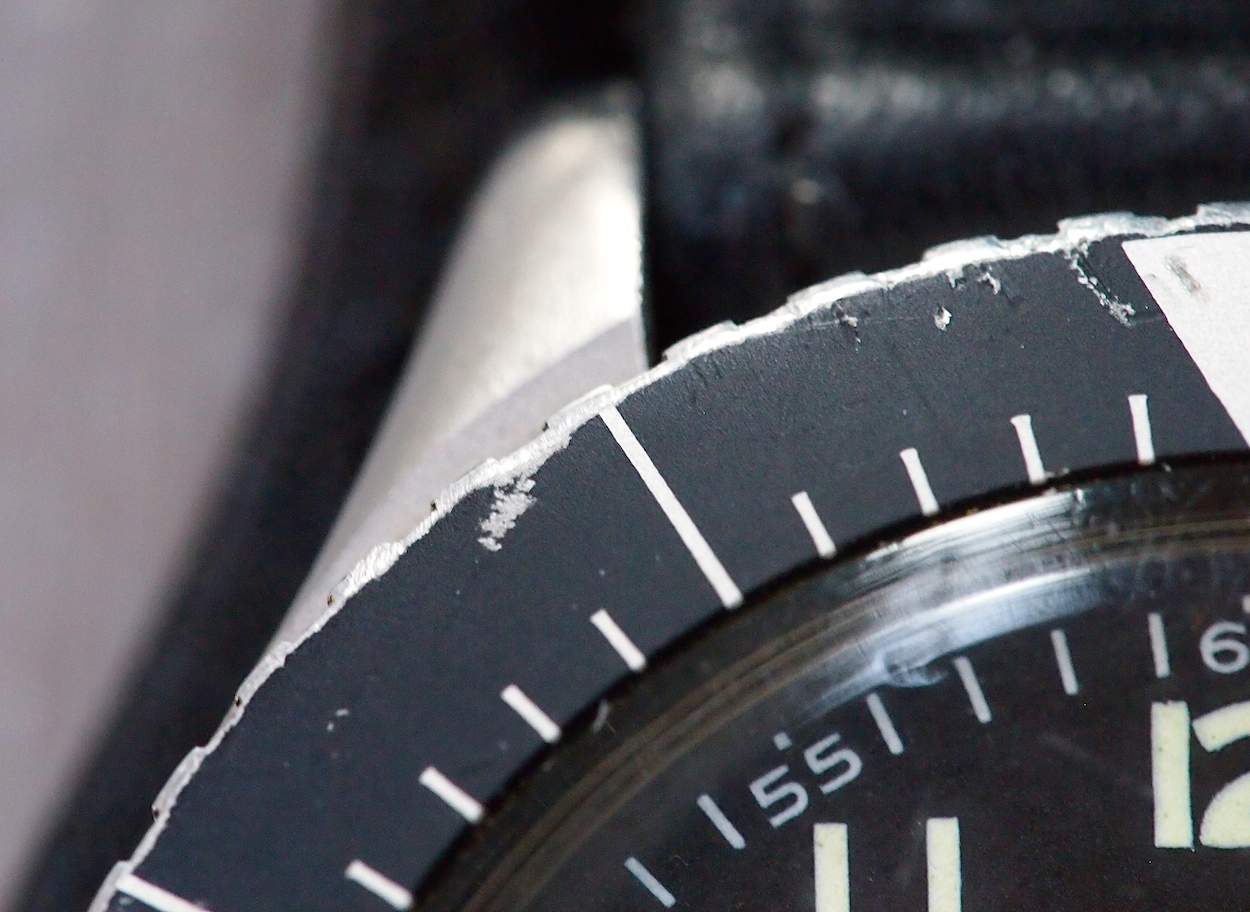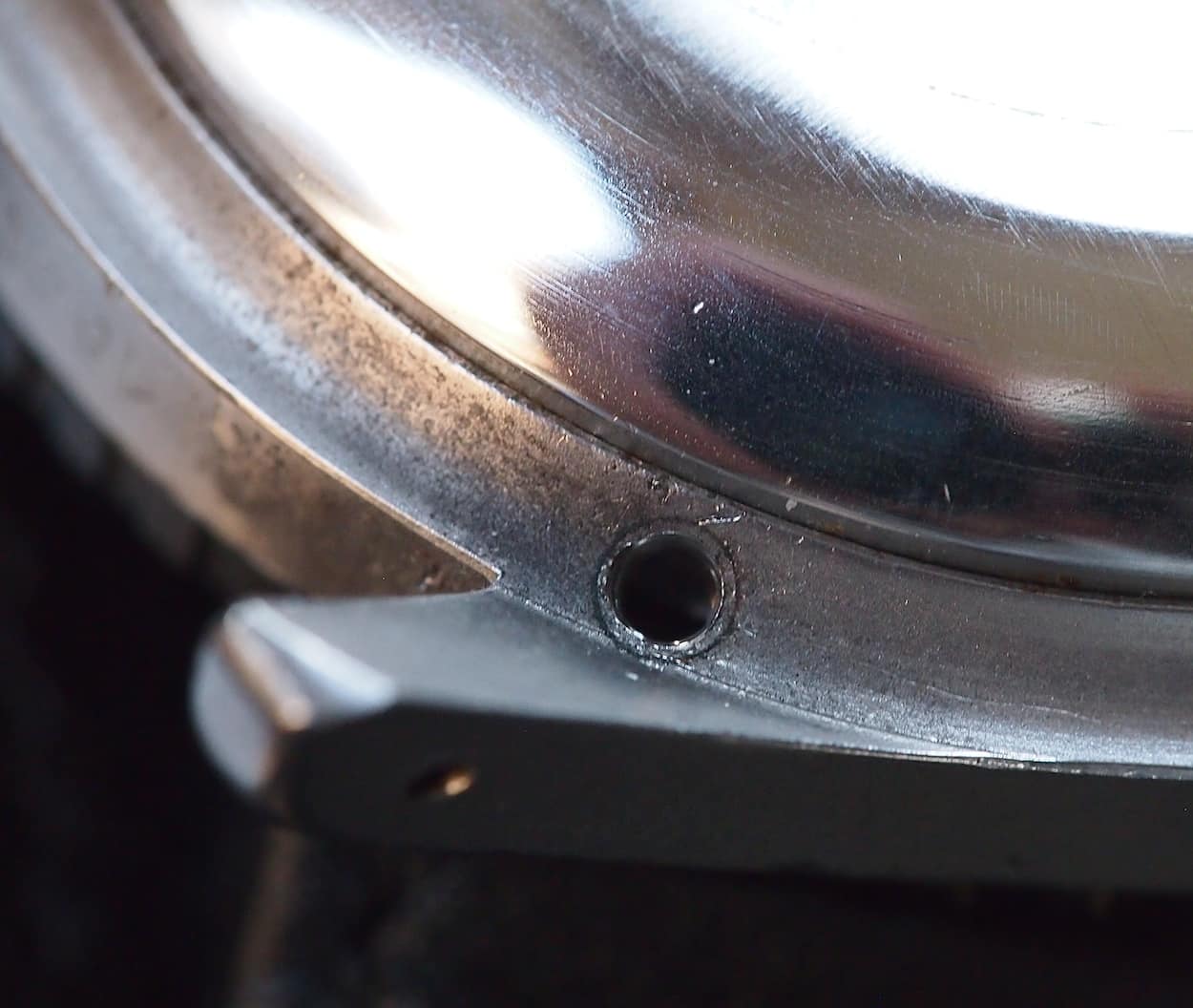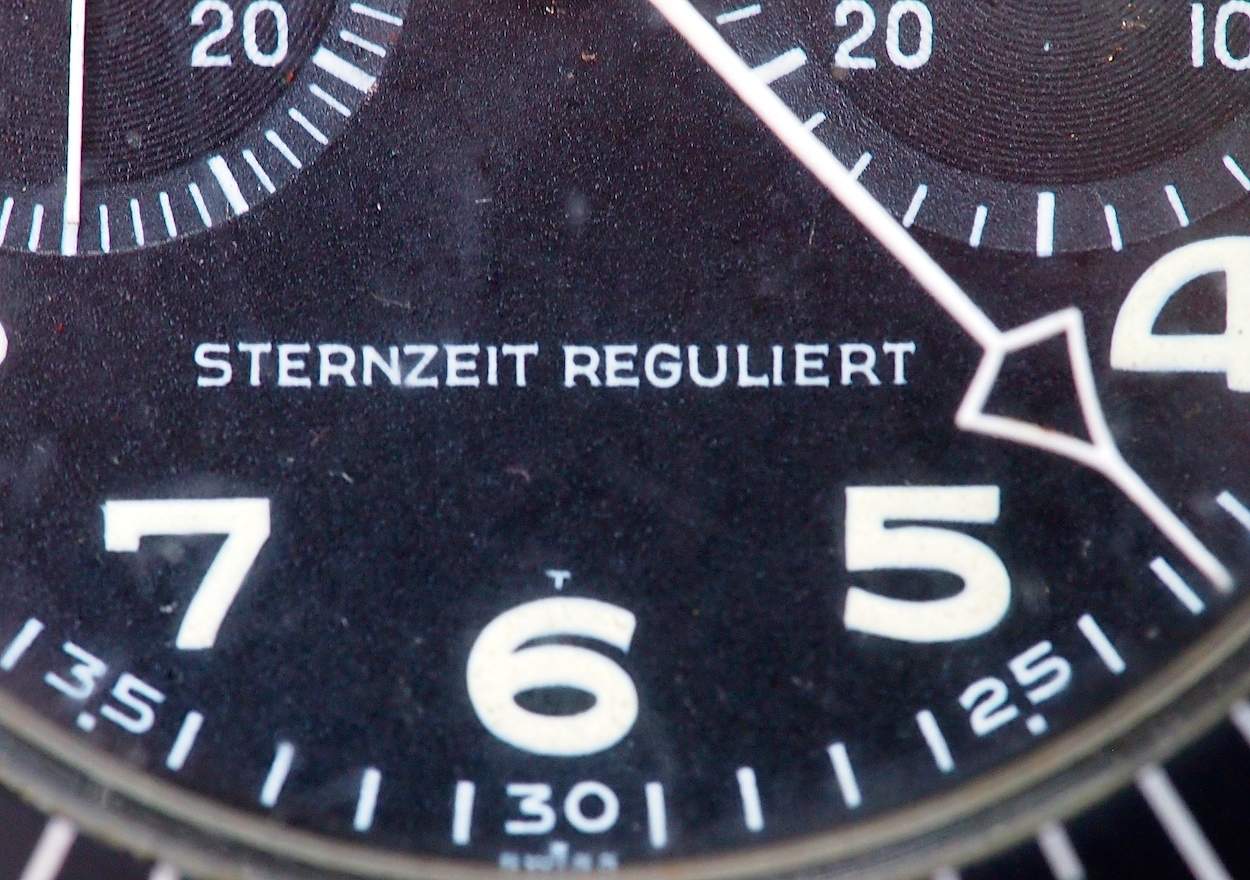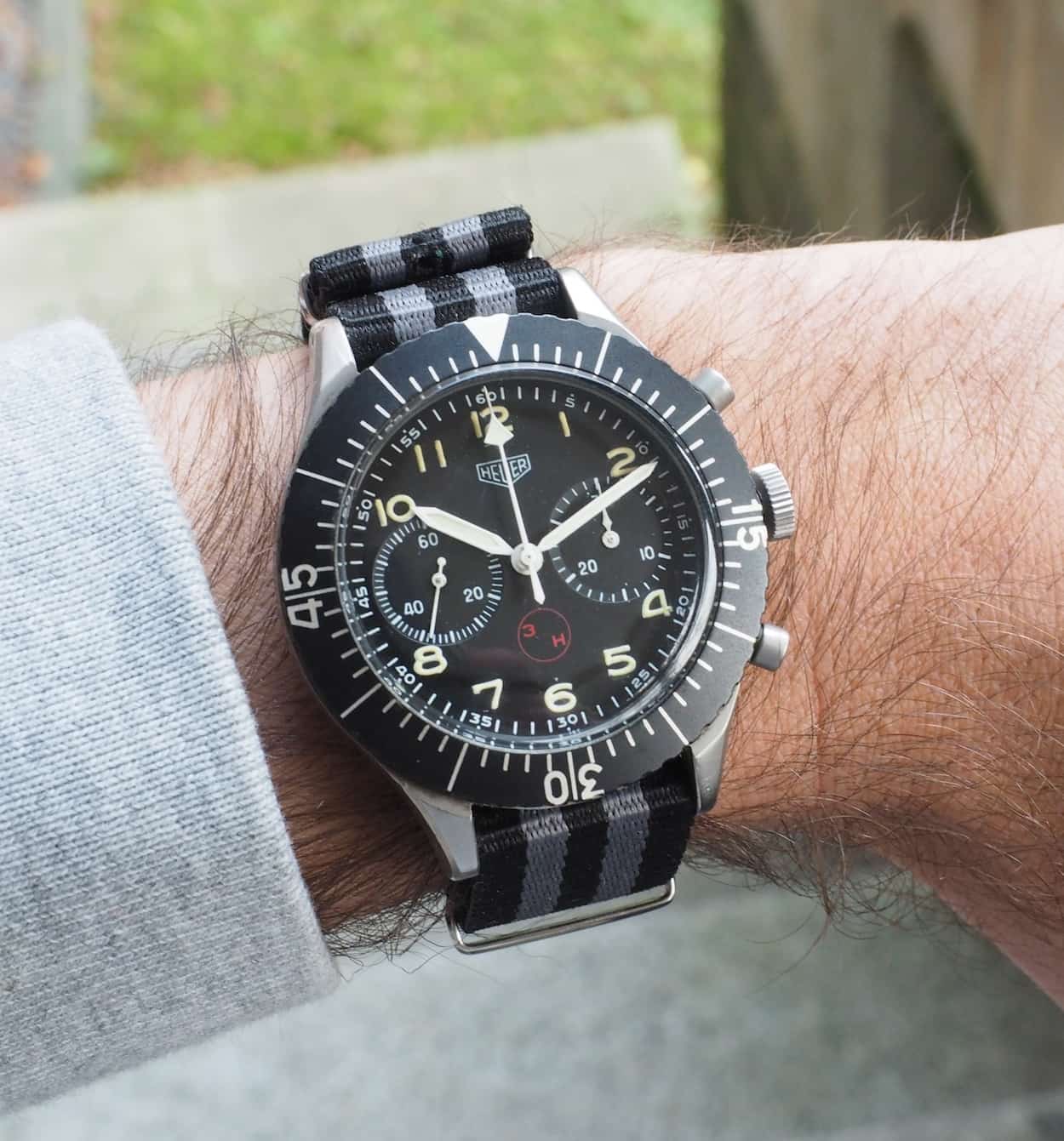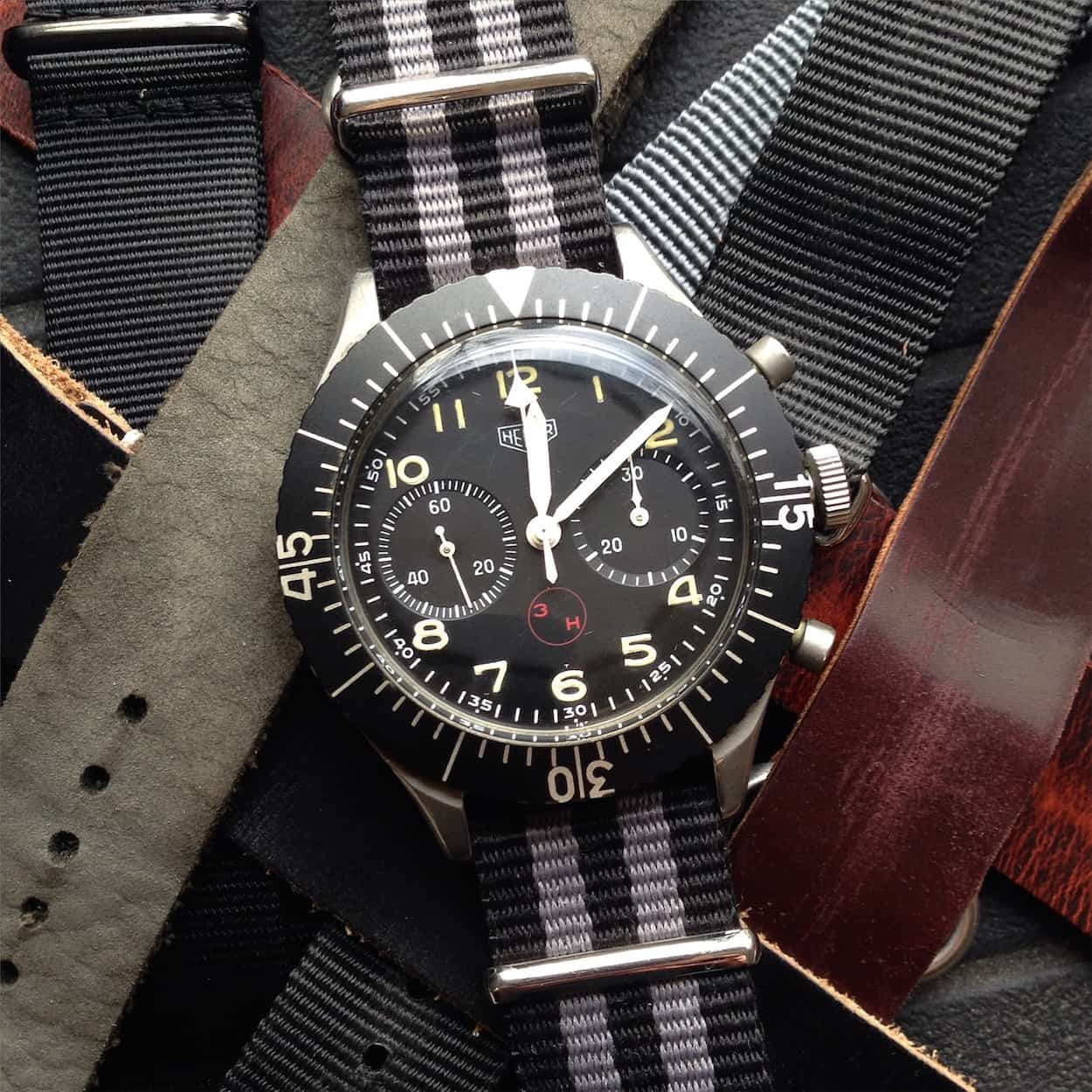#TBT Leonidas Military & Heuer Bund Chronographs
A Happy Holiday to all of you who are celebrating! Forgive the late publish today on Christmas Eve, but I’m currently on holiday in the state known as “Flori-duh” – where the craziness may begin early, but little gets done until late. Double that with a household full of kids and you really get the picture! Enjoy the time…and grab an egg nog and sit down for a lengthy read!
December 4, 2015 was the Friday before I left Germany for the USA in the name of business and pleasure. Normally, a week before I leave for such a trip, I think about what it is that I need to do on the weekend to prepare for such a journey. Boring tasks such as visits to the grocery store, packing, or taking care of mundane errands normally fills the space. This very Friday and the ensuing weekend, though, were slated to be quite different. You see, I had the mother lode arriving in my hands: if only for a short while. To me, December 4, 2015 will forever be remembered as Bund-tag – or Bund-day for those of you who don’t “sprechen sie”. Why? Well, I had 4 of them arrive on that very day and, by the way, each piece was highly unique.
The Bund…new or old or both?
The Bundeswehr chronographs notably made by Heuer and Leonidas (in this case for the Italian military and before Heuer bought the company) are the stuff of legends. These big, 42mm diameter flyback chronographs with killer looks are amongst the most well known military watches on the planet, but for some odd reason, while most other early Heuer models have long exited the realm of affordability, the Bunds have comparatively languished – at least up until recently. Why is that? Well, as officially issued chronographs, the Bunds were returned by their pilot lessors and serviced. The services often added new dials or movements in order to make the watches fit for duty and I think this has had a lot to do with quelling their values. Chalk one up for enthusiasts, though, because military watches represent a rare niche in the vintage world where service parts are at least deemed as semi-acceptable. For me, though, this mix of old – often in the case of the…case – mixed with bright white hands or dials just felt odd. So, I’d passively been looking for a solid Bund when I started chatting with @watchfred. And Fred, after doing some serious mining, tapped a serious ore vein.
Fred stumbled upon a collector in Germany who has put together a fairly impressive vintage watch collection. For one reason or another, though, the collector considered letting go of his Bund collection. We’ll talk about what a collection of Bunds means because, honestly, I was really only aware of a couple different variations. In any case, a couple weeks of sketchy dialog followed and Fred was able to put together the deal that allowed for 4 watches to make their way to me for roughly 4 days for the purpose of capturing them on my Olympus. Folks, when I say I was dumbfounded upon opening the box that arrived via courier, it’s no joke. These watches are sublime. Before I list the watches that were included, let’s talk a little more about the Bunds, some of the lore, and some other reasons as to why I previously resisted purchasing one of these.
The Bund is made up of legendary stuff
Some history, but not much, is in order. I won’t recount the entire history of these watches in great detail because the article of all articles, at least as far as variations and classifications is here. The watches were originally issued in the 1960’s to either Italy or Germany and were around for decades. In fact, Sinn, under its original ownership, did a lot of the servicing of these watches under official contract in the later years. The watches, as mentioned before, were sent in and parts were swapped out as necessary to make them ready for duty. This, by the way included movements, which is why it’s possible to find the Valjoux 22, 222, or 230 per this article from our friends at WoundForLife.
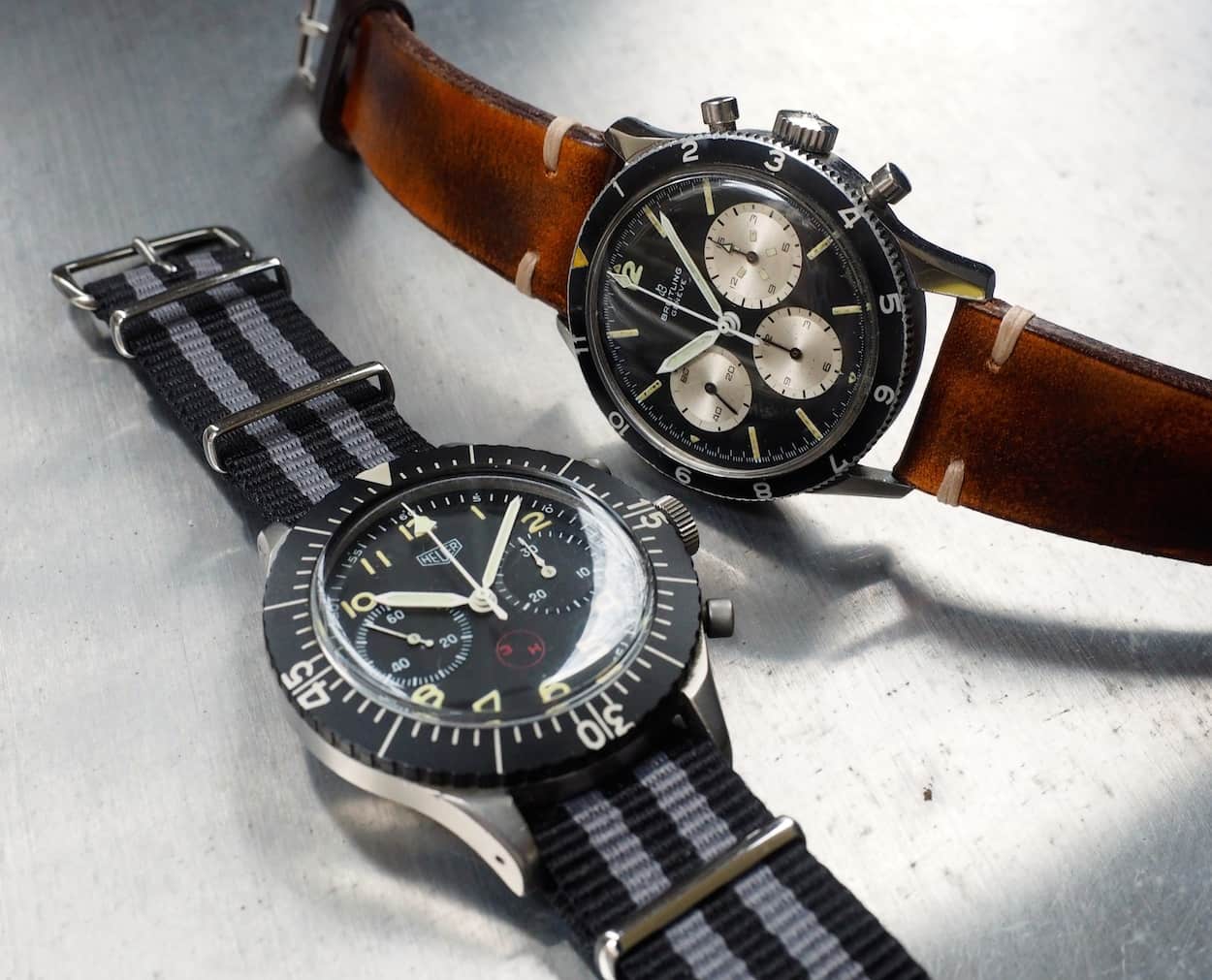
Next to another big pilot’s watch…the Breitling 765CP is one piece that doesn’t cower to the size of the Heuer Bund
You’ll have to pry the Bund from my cold, dead hand…
Regarding the Bunds and their following, I must say that I’m blown away that the Bunds are still relatively affordable and available because out of many of the watches I own or have studied, the Bund must rank near the top as having one of the most passionate crowds of owners. Seriously, I’ve read many posts where owners talk about how this will be the only watch they’ll own if they’re forced to get rid of everything else. Why is that? Well, to sum it up, the looks of this watch are epic and the brand name doesn’t hurt either. The watches, with their big cases and bezels, look something like an upsized Autavia but fit in well with other military pieces such as the Cairellis, etc. They’re bold, rugged looking and have fantastically clear dials as well. The fact that the watches contain column-wheel chronograph movements within their front-loader cases that “flyback” and hack doesn’t hurt either. Honestly, my only reservation in the looks department was the employment of a 20mm lug width. I thought that 21-22mm was more in order like the lovely Breitling 765CP I reviewed, but to be honest, 20mm works. So, yes, this watch is darn near perfect aesthetically. I’m not sure if it would be the last watch on my wrist, but I now understand why people are so excited by them.
Let’s head back to why I resisted picking up a Bund. First of all, the Bunds are relatively plentiful in one form or another. Apparently, Germany was really pumping out some pilots in the 1960’s and 1970’s because there does seem to be a fair number out there. So, in my mind, it was one of those watches that I felt would always be available. But, I said that about vintage Speedmasters and we all know what’s happened in that market. Second, I resisted the Bunds because I’ve never really been into military watches. I have nothing against them, but I find it to be a frustrating market as far as authenticity. I mean, really, head over to eBay and check out all the junk listed as issued to Swedish or Argentinian forces. Is the stuff real or the work of a scammer with a tool in his garage? I’ll let you decide, but I’ve never been willing to shell out extra money because some doofus in Uruguay claims dubious military provenance. Needless to say, I’m slowly shifting my opinion, but the pickups will be slow and steady.
The cursed cuff!
The cuff. Bunds were issued on a military spec leather cuff that apparently protected the pilot’s wrist from extreme temperatures from the metal case back. The hardcore crowd of Bund lovers tends to be pretty pro-cuff. I’ve never liked these straps because I find them ugly and they remind me of sleazy shops in Fratello’s home country that sell leatherware for activities discussed in “50 Shades of Gray”.
Oh, and with my wrists, the cuff would be more appropriate as a collar. Thankfully, if there were ever a watch that screamed for a NATO or one-piece strap, the Bund is it. These watches look fantastic with NATO’s, Zulus, or whatever you decide to call them – and almost any color will do. Oh, and while we’re talking straps, I should mention another ingredient within this stew of a nearly perfect watch, the lugs are cross-drilled to make changes fast and simple.
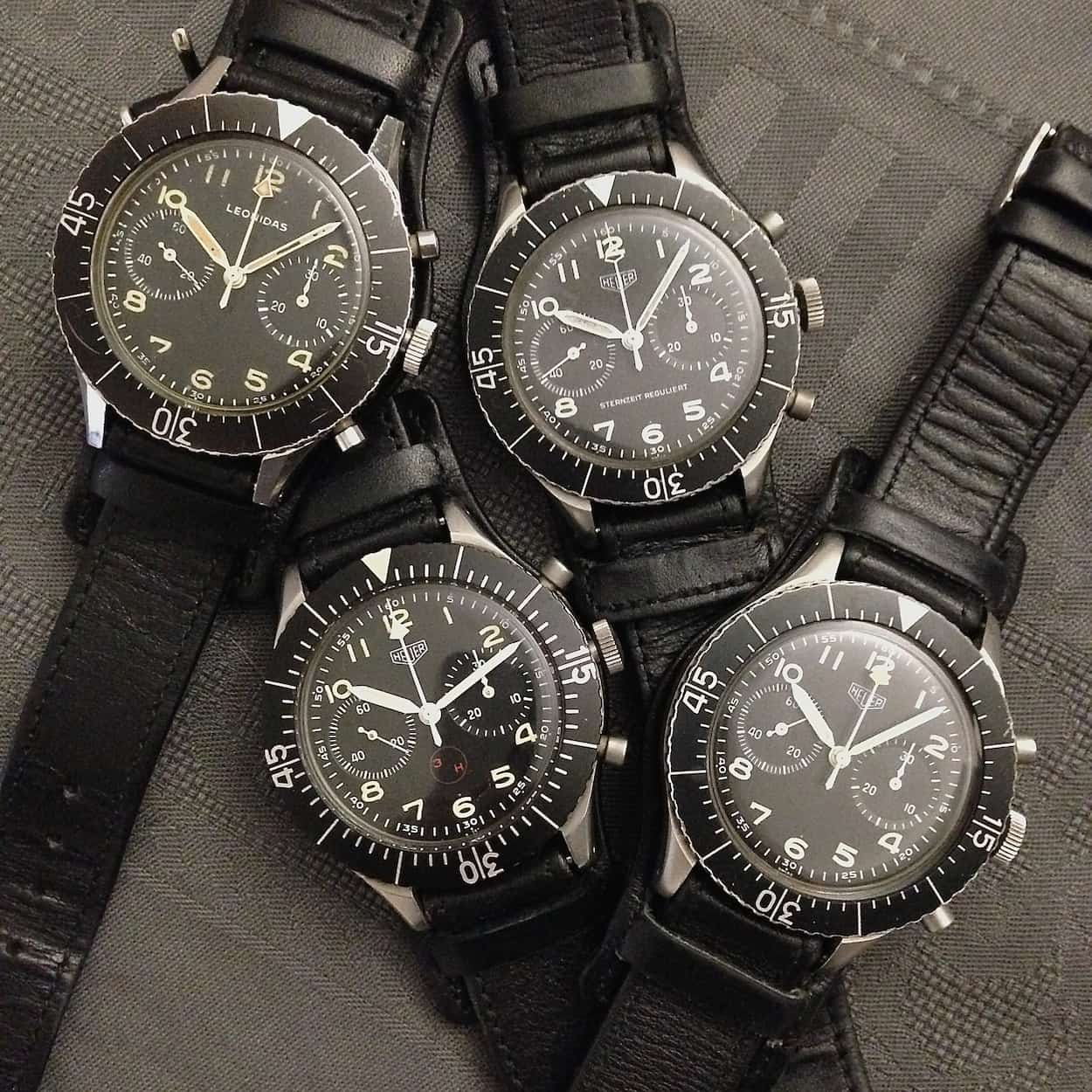
Fred and Andreas were a little concerned that I might change my name and run away with these beauties
What’s in the box!?!?
Coming back to December 4th, what exactly was in the box? Well, here they are:
- The Leonidas Bund – the original before Heuer bought the company in the mid-1960’s. Thanks to one of our readers pointing out the error, this piece was issued to the Italian Army – not Germany. This watch has joined Fred’s collection (the Breitling’s had better be on their best behavior with this big dog joining the fray)
- The Heuer Bund Sternzeit 1551 SGSZ – the rarest of all the Bunds is also joining Fred’s museum.
- The Heuer Bund 1550 SG “3H” – this one joins my collection thanks to Fred.
- The Heuer Bund 1550 SG with tritium dial – this one is now with Andreas and is for sale on eBay.
Now, let’s spend a few paragraphs on these pieces and I’ll attempt to compare and contrast them.
The Leonidas Military watch – the grandaddy of them all
Starting with the Leonidas, this is the granddaddy of all the Bunds. At first, I really wondered if there was a difference between this piece and the Heuers aside from the name on the dial. At first glance, the dial looked similar, the hands are essentially the same and the subdials have their 2 different hands. The difference really lies in the case.
Whereas the Heuer’s have what can only be described as a matte, shot-blasted case, the Leonidas has a polished steel case. The Heuer’s also contain matte-finished pushers and unsigned crown while the Leonidas’ are polished.
The differences continue, though, because the case on the Leo contains lugs with chamfers that remind me a lot of the aforementioned Breitling or even the 2nd execution Autavia 2446 that I reviewed earlier this year.
Finally, the Leo has a different issue number on the back denoting its issuance to the Italian Army with E.I. or “Esercito Italiano”.
There’s a real elegance to the Leonidas that is lacking on the Heuers, but what the Heuers may lack in grace, they make up for with purpose.
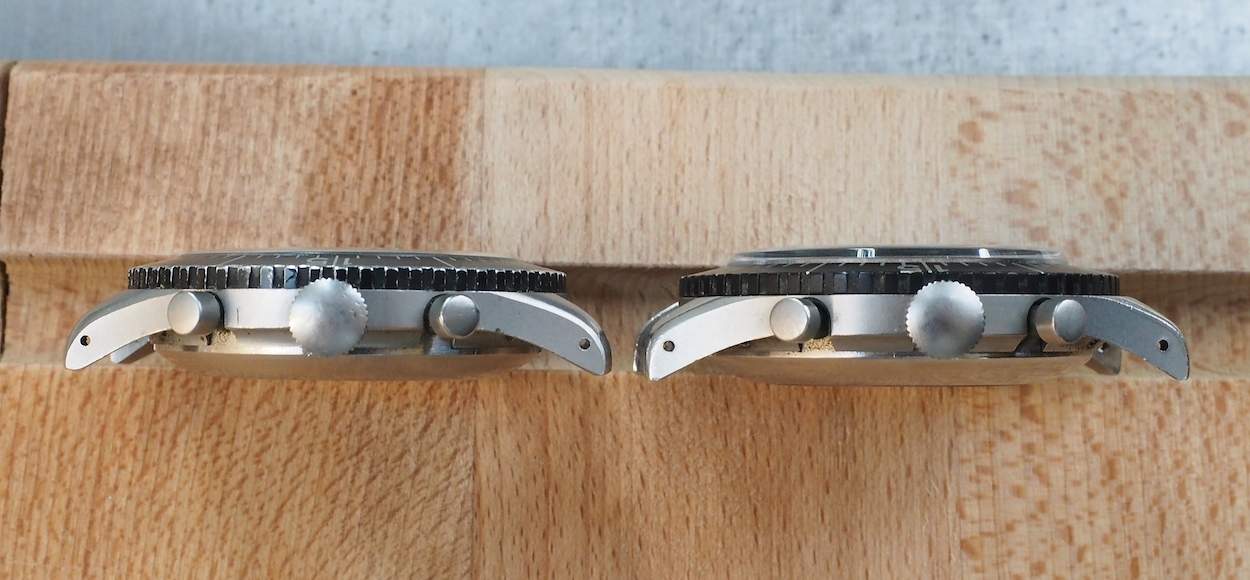
Looking at the Heuer Bund and the 3H…note the difference in the crystals and the way the lugs slope downward
All 3 Heuer Bund models contain similar cases, but you can see that 2 pictured above side by side (the 2 1550’s) contain slightly different designs as far as the lugs are concerned. I have no idea if this is related to different contractors, different tools, or age. You’ll also see that the crystal on the 3H is not exactly flush like the other models. Like I said, there are lots of variants out there.
The Sternzeit…good luck finding one of these!
The Sternzeit, or 1551 SGSZ, while not the oldest of the bunch, is certainly the most rare and valuable piece of the bunch.
These were issued to artillery units in the early 1970’s according to a tz-uk article and apparently were regulated to a standard that ran 4 minutes slower than normal time to aid in targeting objects via astro-navigation. See the article as it’s fascinating stuff.
Here again, aside from the marking on the dial, the model number and different military issue number on the case back, this watch is very similar to the other Heuers.
The “3H”…the popular choice
Regarding the 1550 Bunds, the big difference between the two is, once again, the dial markings. The “3H” as it is known, features, well, a “3H” within a red circle to denote the use of tritium because Hydrogen 3 is the chemical composition for the glowing stuff. This version contains the 3H with a small dot in the middle.
This is just one of the possible 3H variants out there. Note that the hands look like they were likely swapped during service.
The plain Jane 1550 SG…and it’s beautiful
Coming to the last piece, we have the Bund 1550 SG. To be honest, when I viewed all four of these, this was my favorite as far as patina and aging. The bi-directional bezel is wonderful, contains a thinner, earlier font, and the hands are amazing. Plus, it has a beautifully simple dial.
This piece shares the same military spec as the “3H” so it’s really a product of having a different dial from a different production era. Honestly, it’s sublime and I know that it was difficult for Andreas not to add this to his collection instead of putting it on the market.
Coming back to some overall observations, all 3 Heuer Bunds contain smaller “Heuer” logos, which means that they’re earlier production models. Another “tell” is that the 2/4/8/10 hours are not “cut off” like later service dials. These later dials, by the way, aren’t really perceived as value killers in today’s market. It’s odd stuff, but the community seems to talk about or point out later Sinn-serviced pieces, but it seems that the market prices aren’t incredibly different for the variants at this stage.
Buying a Bund
There are some interesting things to watch out for when buying a Bund. I think the most common sign of a fake is the lack of a “flat spot” at the top of the lugs to allow for appropriate bezel mounting. I also think that the article I reference at the very beginning is a good place to start as a source of comparison when you’re looking at a given piece. Of course, the chronocentric forum is helpful as well as any large forum devoted to military watches. The positive is that replacement parts are out there, but I see that they’re starting to become scarcer. Oh, speaking of replacement parts, when I received the 3H, I noticed that one case back screw was poking out a bit more than the others. Foolishly, I let it be and decided to wear it around for a day.
Later, when shooting the watch, I noticed it was gone – probably somewhere on the streets of Frankfurt. Needless to say, finding a “slotted 1.6mm grub screw with dog point” was not so easy and cost 25 Euros. So, a tip from your author would be to do some tightening every so often. Otherwise, the movement will be exposed and you’ll get to spend silly money on microscopic piece of steel.
Finding a Bund isn’t so difficult depending on what variant you’d like. If you’d like a Leonidas, they’re out there, but prepare to pay about $4,000 – 5,000. If you’d like a Sternzeit, good luck. If you do find one and the seller knows what he has, prepare to shell out well over $10,000. When we come to the more commonplace Bund 1550 SG’s, assume prices anywhere from $3,000 – 5,000 depending on condition, markings, etc. As always, vet the heck out of these things amongst your trusted watch community. I do know that the Bund for sale by Andreas on eBay is a great piece, he’s a great seller and he’s negotiable too (not a push there, but more of an FYI).
Wearing a Bund is…sublime
I really enjoy wearing my 3H. It’s big, kind of mean looking, but exudes quality. Plus, as I mentioned, I can class it up on a leather Horween NATO or I can make it as casual as possible with a nylon Zulu. It’s not small on me by any means, but it does fit pretty well. It’s probably one of those watches that don’t work very well at most offices, but I tend to slip it in through the door on Fridays. Really, with modern sizing, military provenance, one of the hottest names in vintage watches (Heuer), and a rotating bezel, the Bunds deserve a higher level of recognition from collectors. If the recent market gives us any signs, I’m guessing that Bunds will begin their climb any day now.
Thanks for taking the time to read about 4 very similar, yet different interpretations of the classic Bund watch. My article is not meant to really “set the record straight” on these watches as far as history or to be an exhaustive guide, but really more to give you an impression on some key variants. These are great watches for the chronograph collector, Heuer collector, or military watch collector. There are few pieces out there that are as attractive as the Bund, so hopefully you’ll not make the mistake that I commonly do, which is to wait until they’re tough finds. Enjoy the holiday and, as always, feel free to share your thoughts and pictures below!

